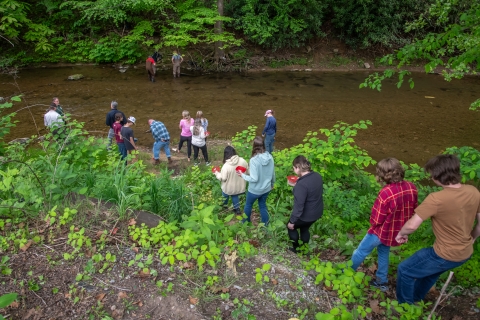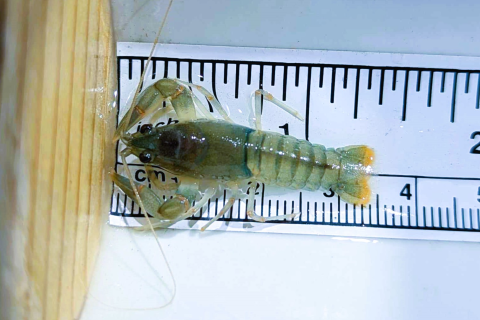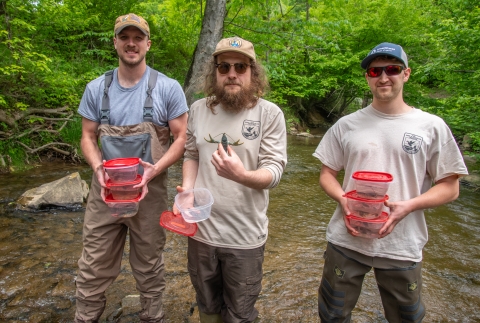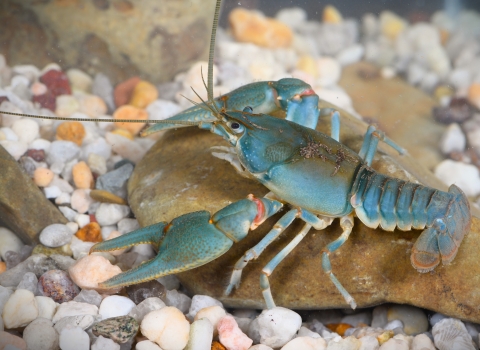With the holiday season quickly approaching, many of us take time to reflect and share our gratitude with the ones we love. As we begin our travels and migrations home for the holidays, one homecoming story in Virginia stands out among the rest. For the iconic Big Sandy crayfish, home-sweet-home is the sandy, pebbled river bottom of the McClure, the 17.9-mile-long river that flows through the heart of central Appalachia.
While some would hardly qualify the McClure River as a creek, what she lacks in size she makes up for in beauty and diversity. The Service and it’s partners Virginia Department of Wildlife Resources and West Liberty University are working to maintain this diversity, including bringing the bright blues, greens, and teals of the federally threatened Big Sandy crayfish home to the McClure, just in time for the holidays.
Like all crayfish, they play many important roles in our streams — feeding on macroinvertebrates in the summer months, like small riverine predators. They are also shredders and actively break down leaves and other organic matter whose nutrients are used by other river organisms in the food chain. Crayfish also play an important role in the food web as prey for other predators including fish, birds, reptiles, amphibians and mammals.
Unfortunately, mining, timber harvest and other activities that can increase sedimentation have shrunk their habitat and left the crayfish vulnerable to becoming endangered. In 2016, Big Sandy crayfish was listed as threatened and is now protected under the Endangered Species Act. Since 2018, biologists at White Sulphur Springs National Fish Hatchery (NFH) have been working alongside the Virginia Department of Wildlife Resources and West Liberty University’s Crayfish Conservation Laboratory to raise Big Sandy crayfish in captivity for release into the wild . This team specializes in rare and endangered species.
Propagating Big Sandy crayfish was easier said than done. With no other facilities doing this work with endangered species, the dedicated team paved their own way through this conservation challenge, resulting in huge milestones year after year.
In the initial years, the team had been collecting sexually mature female crayfish from tributaries in the Big Sandy River basin in the spring and bringing them to the hatchery, optimistic that each crayfish had mated and would lay eggs — but this often wasn’t the case. Some crayfish weren’t fertilized and wouldn’t lay eggs at all. Some would only lay a few eggs, while others laid more. It was inconsistent and stressful to the animals without sufficient results or benefits to the species.
In 2023 we waited until summer and collected fertilized eggs and newborns from the mothers in the wild. With this new method, they could leave the adults in the river and eliminate the stress from captivity. Nearly half the collected animals survived their first three and a half months, advancing through the natural mortality points during their development. Their survival rate was about three times better than what would be expected in nature. Not only were they surviving at high rates, but the crayfish thrived at the hatchery. In the wild, Big Sandy crayfish grow to adult size — about as large as a human hand — in two years. In the hatchery, it took less than nine months.
These efforts culminated in the release of 77 animals in May of 2024. Following the release, White Sulphur Springs NFH and partners immediately began planning for the next season when the cycle would start over. The team set out with a new goal, get the animals back in the river before winter. This challenge presented several issues the first of which was time.
In the past, juveniles were collected around the first of September. This left a window of around two and a half months to get the animals up to size before water temperatures dropped below 50 degrees, usually around Thanksgiving. In order to release the crayfish, they need to be tagged, and in order to be tagged they need to be around 20 mm or ¾ of an inch. The baby crayfish hatch at around 6mm, so they had a little over 60 days to grow 300%.
In late August of 2024, the team collected 137 eggs and juveniles and began the tedious culture process, making adjustments and improvements from the previous season. The crayfish moved into their condos the second week of September.
Over the following weeks the crayfish began to feast and grow. Over the course of just 60 short days, the animals grew ~20 mm. This meant that they could tag and release them. After only 90 days, 107 crayfish were packaged like Thanksgiving leftovers and released back into the McClure, the largest release to date.
This project has been a profound experience for the dedicated biologists and partners who worked hard to make it a success The timing of these releases is fortuitous, to be able to celebrate with friends, family, and community and to help restore the McClure River is an extra gift to be grateful for this Thanksgiving.









